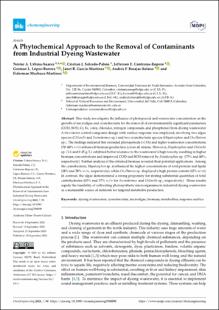A Phytochemical Approach to the Removal of Contaminants from Industrial Dyeing Wastewater
Artículo de revista
2023-09-28
ChemEngineering
This study investigates the influence of photoperiod and wastewater concentration on the
growth of microalgae and cyanobacteria for the removal of environmentally significant parameters
(COD, BOD, Cr, Fe, color, chlorides, nitrogen compounds, and phosphates) from dyeing wastewater.
A two-factor central composite design with surface response was employed, involving two algae
species (Chlorella and Scenedesmus sp.) and two cyanobacteria species (Hapalosiphon and Oscillatoriasp.). The findings indicated that extended photoperiods (>13 h) and higher wastewater concentrations (70–80% v/v) enhanced biomass production across all strains. However, Hapalosiphon and Chlorellasp. (1.6 and 0.45 g/L) exhibited better tolerance to the wastewater’s high toxicity, resulting in higher biomass concentrations and improved COD and BOD removal by Hapalosiphon sp. (75% and 80%,respectively). Further analysis of the obtained biomass revealed their potential applications. Among the cyanobacteria, Hapalosiphon sp. synthesized the highest concentrations of total proteins and lipids (38% and 28% w/w, respectively), while Oscillatoria sp. displayed a high protein content (42% w/w). In contrast, the algae demonstrated a strong propensity for storing substantial quantities of total carbohydrates (65% and 57% w/w for Scenedesmus and Chlorella sp., respectively). These results signify the feasibility of cultivating photosynthetic microorganisms in industrial dyeing wastewateras a sustainable source of nutrients for targeted metabolite production.
- Ambiente y Vida - GIAV [131]
Descripción:
ChemEngineering-07-00090.pdf
Título: ChemEngineering-07-00090.pdf
Tamaño: 4.461Mb
 PDF
PDF
 LEER EN FLIP
LEER EN FLIP
Título: ChemEngineering-07-00090.pdf
Tamaño: 4.461Mb
 PDF
PDF
 LEER EN FLIP
LEER EN FLIP
Excepto si se señala otra cosa, la licencia del ítem se describe como © 2023 by the authors. Licensee MDPI, Basel, Switzerland. This article is an open access article distributed under the terms and conditions of the Creative Commons Attribution (CC BY) license (https:// creativecommons.org/licenses/by/ 4.0/).

















